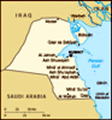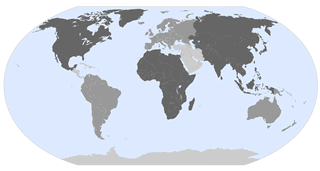Advertisement
Published: February 27th 2012
It was another of those not-so-auspicious starts. First, I had mistakenly paid for a set of visa stamps I didn’t need, as I stumbled through the very unclear visa process – head up to the departure lounge (really?), get a copy of your passport made, take a number, fill out this form, buy the visa stamps from a vending machine (oops, except if you are from the UK or US!), get an 8x11 paper that serves as your visa (don’t lose it!), get your entry stamp, and THEN head downstairs to immigration. Second, I couldn’t, at first, get a taxi driver to take me into town. The first guy, a grizzled old Kuwaiti man in gutra, puffing away on a cigarette, took one look at me, and, before I could explain where I wanted to go, waved his hand dismissively: “Mushkila!” (“Problem!”) How is it a “mushkila”? You don’t even know where I’m trying to go! Finally, I got a driver willing to take my fare. But then he had no clue how to get to my destination…
Welcome to Kuwait!
But any negativity I felt after these little arrival “adventures” soon vanished as I really began my explorations.
Not unlike my experience in Prague several summers ago, first impressions proved erroneous.
***
Kuwait is not generally high on most people’s travel lists. Unlike, some of its neighbors – notably Dubai, and increasingly Doha – which are major transit hubs and major tourist draws in and of themselves (if, for anything, their shopping opportunities), Kuwait is generally a destination for business types. One rarely goes to Kuwait unless one has to go there. Thus, I raised a few eyebrows when I told people I was going just to go. “Isn’t it just a bunch of glitzy malls?” they asked….
But I’ve never been the type to follow the typical tourist routes. I had my reasons, of course, for wanting to spend a long weekend in the tiny country, essentially a city-state, at the end of the Persian Gulf. For one, it was formerly an Ottoman territory (albeit nominally so), and those who know me know about what will likely be my life-long project of visiting as many former Ottoman territories as I can. I also sort of wanted to complete my Gulf Cooperation Council (GCC) “tour”. Without really planning it, I have found that I have
been checking off the list of GCC member states: first Bahrain, then Saudi Arabia, the UAE, Oman, and Qatar. All that remained was Kuwait (even if I landed there on my way to Saudi in 2008 - but since I didn't even get off the plane, it doesn't count). Lastly, there’s the simple challenge of discovering what makes any destination, regardless of its tourist appeal, fascinating. If someone tells me a place isn’t worth visiting, it doubles my interest in traveling there!
It didn’t take long for me to discover that there was much more to see and experience than shopping at the latest mall development and stopping for a latte at Starbucks (though I did all that, too!).
***
Once I had managed to get out of the airport and find a taxi driver willing to drive me, I made a beeline to the Tareq Rajab Museum. This gem of a museum is not easy to find, as it is tucked into a residential neighborhood, Jabriya, far from the main sights of the city. Even once we were in Jabriya, no one seemed to have heard of the place; we basically had to stumble on it
to find it. But the search was more than worth the effort.
This museum is housed in the basement of the former home of the first Kuwaiti minister of antiquities, showcasing his private collection of mostly Islamic arts and crafts. Apparently, as he traveled the world, gathering items for the Kuwait National Museum, he would also make private purchases, eventually ending up with an astounding collection of textiles, ceramics, jewelry, and manuscripts from across the Islamic world. But what makes this museum all the more important is that during the Iraqi invasion, when the National Museum was decimated, Tareq Rajab managed to hide his collection by building a false wall in his basement. The priceless artifacts survived the war unscathed. So, as the country tries to rebuild/refurbish the once impressive National Museum, the Tareq Rajab Museum soldiers on.
As I was soon to discover, there were other quirky sights to see hidden in surprising corners of Kuwait City (see my next entry).
***
Unbeknownst to me when I purchased my ticket to Kuwait, my time in the country was going to coincide with one of its biggest holiday weekends – the back-to-back National Day and Liberation
Day. The city was awash in green, white, red, and black, the colors of the Kuwaiti flag; little girls were even wearing dresses in these national colors.
The festivities – which included boys armed with super soakers hosing down passing vehicles on Arab Gulf Road – provided a colorful backdrop to my visit, as well as proving something of a challenge. Some places were closed for the holiday and some taxis would refuse to go anywhere near Gulf Road for the reason mentioned above. I had to plan accordingly.
There were times I simply stuck to the streets of Hawalli, the neighborhood where I was staying, and played the local – drinking tea and coffee, smoking a shisha or two, noshing on great Syrian and Lebanese food (the Levantine Arabs do corner the market on the best Arab cuisine, I must say) – when the craziness of the celebrations prevented me from going further afield.
But the dual holiday – National Day (February 25), celebrating the country’s independence from Britain in 1961*, and Liberation Day (February 26), marking the routing of the Iraqi forces during Operation Desert Storm in 1991 – proved more than anything an excellent
starting point for me to think about Kuwait’s rather intriguing history.
***
The name Kuwait stems from the Arabic word for a small, seaside fort: kout. Somehow it’s a fitting name for the country. This flat, flat wedge of desert doesn’t at first glance seem to have much of a draw, especially for human settlement. Indeed, it wasn't permanently settled until just about 300 years ago. But the territory had one major advantage: it possesses one of the best natural harbors in the Gulf region.
In the mid 1700s, the Bani Khalid tribe from the Najd (the central region of the Arabian peninsula from which the Saudi ruling family also emerged) settled on the coast. They built the original
kout to protect the cluster of Bedouin tents that was the first Kuwaiti “city” and appointed Sabah I bin Jaber to be their leader. From these humble beginnings, a distinct Kuwait would emerge – one that has been ruled by the al-Sabah family ever since (although sometimes with outside “guidance”). Under the al-Sabah, Kuwait grew from a cluster of tents surrounding a fort to being a more permanent settlement that eventually played a key role in
the lucrative trade – pearls, spices, dates - that passed through the region, both through its growing prowess in the Gulf itself and as a transit point between overland and sea trade.
While the Ottomans generally claimed sovereignty over the region, their control of Kuwait was never very tight, especially in comparison to the region that became Iraq or even further down the Gulf coast in al-Hasa. In attempt to keep the Ottomans at bay, Emir Mubarak al-Sabah aligned himself with the British, first signing a treaty in 1899 that gave Britain control of much of Kuwait’s foreign policy and later, in 1913, pushing for the Anglo-Ottoman Convention that got both Britain and the Ottoman Empire to formally accept al-Sabah authority in Kuwait. This convention would prove short-lived, however, because Britain, as soon as WWI was over, declared it – like other Gulf states - an “autonomous” part of the British Empire (i.e. a protectorate).
During the first half of the 20
th century, Kuwait would remain a sleepy, pearl producing corner of Britain’s vast empire. But the discovery of oil in 1938 set Kuwait on path that would change it and the Gulf forever. Kuwait City would grow
from a small community of low-slung mud brick buildings surrounded by a mud brick wall to a sprawling city of multi-lane highways and towering, state-of-the art skyscrapers. It would go from being one of the poorest countries in the world to one of the wealthiest. All in the matter of a couple generations.
Such rapid growth is never easy; Kuwait is now struggling to find its balance as it both recovers from the setback of the Persian Gulf War and enters full steam into the 21
st century.
***
Even though I tried not to listen to those who claimed that Kuwait was just a collection of malls, I really didn’t expect to find many – if any - physical remains of the city’s earlier history. But if you look closely, the Kuwaiti past rubs shoulders – perhaps uneasily at times – with the Kuwaiti present and future.
On my last morning, I jumped into a taxi and headed to the last stretch of Gulf Road I had not explored. In the brisk morning (coming from Sudan I was taken aback by how chilly the Kuwait winter was at times!), I strolled, almost alone, along the portion
that marked the original town. With a backdrop of futuristic skyscrapers on one side and the blue expanse of the Gulf on the other, I stumbled on one treasure after another. Dhows, those ancient pliers of trade around the Indian Ocean, bobbed in a harbor right next to the Sharq Souq Mall (yes, a mall); white-washed buildings with heavily carved wooden doors have been refurbished and re-appointed as government offices; the not-so-lovely, boxy house of the last British governor holds out in the middle of a large construction project; the elegant Sadu House, one of the last remaining pre-oil era houses, serves as a museum of traditional Bedouin textiles/weavings; a short distance in from the coast, right in the downtown area, a lively, full on souq in the old style sprawls with all the wares one could hope to find. This is a Kuwait that many overlook, I think.
And it’s the Kuwait I will remember. Not a misanthropic taxi driver who wouldn’t give a khawaja a break…
*A little oddly, February 25 is not the day Kuwait gained independence from Britain – that was June 19, 1961; rather it is the date when Sheikh Abdullah
al-Salem al-Sabah, who negotiated for independence, came to the throne.
Advertisement
Tot: 0.105s; Tpl: 0.013s; cc: 11; qc: 24; dbt: 0.0639s; 1; m:domysql w:travelblog (10.17.0.13); sld: 1;
; mem: 1.1mb






















Eric
non-member comment
Nice trip
Kuwait is not a popular country, but worth a visit, especially in a long-weekend. What flights did you choose to reach Kuwait? BTW, Americans really have advantages because most countries don't require a visa to them. How lucky being an America